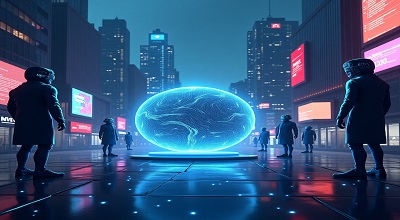AI-Powered Cyberattacks
AI-Powered Cyberattacks: The rapid advancement of artificial intelligence (AI) has revolutionized industries, but it has also given cybercriminals powerful new tools. In 2025, AI-powered cyberattacks are more sophisticated, stealthy, and destructive than ever before. Businesses, governments, and individuals must stay informed about these evolving threats to protect their data and systems.
In this comprehensive guide, we’ll explore the latest AI-driven cyber threats, real-world attack examples, defense strategies, and future predictions.
What Are AI-Powered Cyberattacks?
AI-powered cyberattacks leverage machine learning (ML), deep learning, and generative AI to automate, enhance, and scale malicious activities. Unlike traditional attacks, AI-driven threats can:
- Adapt in real-time to bypass security measures.
- Mimic human behavior to evade detection.
- Generate highly convincing phishing content (deepfake audio/video, AI-written emails).
Why Are AI Attacks More Dangerous?
- Speed & Scale: AI can launch thousands of attacks simultaneously.
- Precision Targeting: AI analyzes victim data for personalized attacks.
- Self-Learning Capabilities: Attack methods improve over time without human input.
The Rise of AI in Cybercrime
Cybercriminals are increasingly adopting AI due to:
1. Accessibility of AI Tools
- Open-source AI models (like ChatGPT variants) are repurposed for hacking.
- Dark web marketplaces sell AI-powered malware kits.
2. Automation of Attacks
- AI bots conduct phishing, credential stuffing, and DDoS attacks autonomously.
3. Enhanced Social Engineering
- Deepfake voice scams trick employees into transferring money.
- AI-generated emails bypass spam filters with near-perfect grammar.
Latest AI Cyberattack Techniques in 2025
1. AI-Generated Phishing & Spear Phishing
- Attackers use AI to craft hyper-personalized emails, mimicking CEOs or trusted contacts.
2. Deepfake Blackmail & Fraud
- AI clones voices of executives to authorize fraudulent transactions.
- Fake video calls impersonate high-profile targets.
3. Autonomous Malware
- AI-powered malware adapts to evade antivirus detection.
- Self-propagating worms infect networks faster than humans can respond.
4. AI-Driven Password Cracking
- Machine learning predicts password patterns, cracking them in seconds.
5. Adversarial AI Attacks
- Hackers manipulate AI security systems with deceptive data inputs.
Real-World Examples of AI Cyberattacks
1: AI-Powered CEO Fraud Scam (2025)
- A European company lost $25 million after AI cloned the CEO’s voice in a fake call.
2: AI-Generated Ransomware Attack
- A hospital’s network was encrypted by self-learning ransomware that bypassed legacy defenses.
3: Deepfake Political Disinformation
- AI-generated fake videos influenced election campaigns in 2024.
How AI is Used for Cybersecurity Defense?
While AI fuels cybercrime, it also strengthens defenses:
1. AI-Powered Threat Detection
- ML algorithms identify abnormal network behavior in real time.
2. Automated Incident Response
- AI systems isolate infected devices before human analysts intervene.
3. Behavioral Biometrics
- AI detects unauthorized access by analyzing typing patterns and mouse movements.
4. Predictive Security Analytics
- AI forecasts potential attack vectors based on historical data.
Future Predictions: AI vs. AI Cyber Wars
By 2026, cybersecurity will become an AI vs. AI battleground, where:
- Defensive AI will autonomously patch vulnerabilities.
- Offensive AI will develop zero-day exploits faster than ever.
- Governments will regulate AI weaponization in cyber warfare.
How to Protect Against AI Cyber Threats?
1. Adopt AI-Based Security Solutions
- Deploy AI-driven firewalls, intrusion detection, and email filtering.
2. Employee Training & Awareness
- Train staff to recognize AI-generated phishing attempts.
3. Multi-Factor Authentication (MFA)
- Prevent AI-powered credential stuffing with biometrics or hardware keys.
4. Regular Security Audits
- Test systems against AI-driven penetration attacks.
5. Zero Trust Architecture
- Assume breach and verify every access request.
FAQs About AI-Powered Cyberattacks
1. Can AI completely replace human hackers?
No, but it automates most tasks, allowing hackers to focus on high-value targets.
2. Are small businesses at risk from AI cyberattacks?
Yes, AI enables attackers to target SMBs with automated, low-cost attacks.
3. How can I detect a deepfake scam?
Look for unnatural speech patterns and verify requests via a separate channel.
4. Will AI make cybersecurity jobs obsolete?
No, but professionals must adapt to managing AI-driven security tools.
5. What’s the most dangerous AI cyber threat in 2025?
Autonomous malware that evolves to bypass defenses poses the biggest risk.
Conclusion
AI-powered cyberattacks in 2025 are smarter, faster, and harder to detect. Organizations must leverage AI-driven security measures and stay vigilant against evolving threats. By understanding these risks and implementing robust defenses, businesses can safeguard their digital assets in the age of AI cyber warfare.

